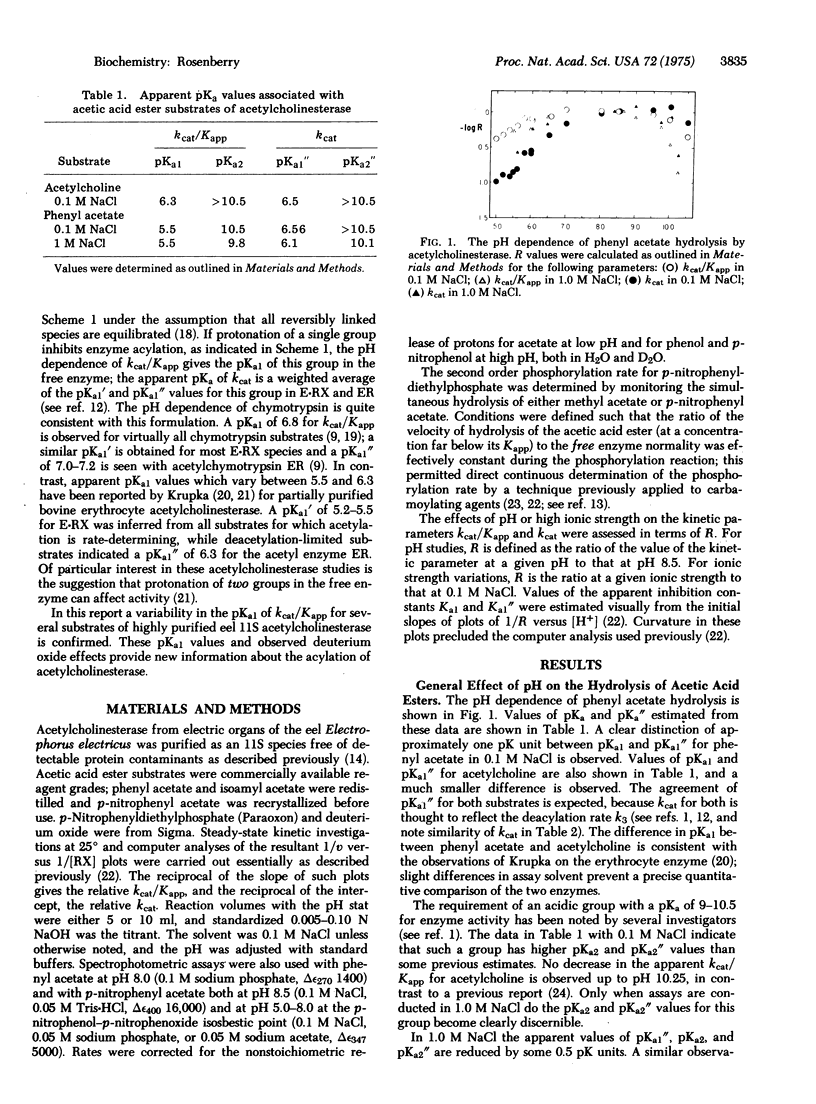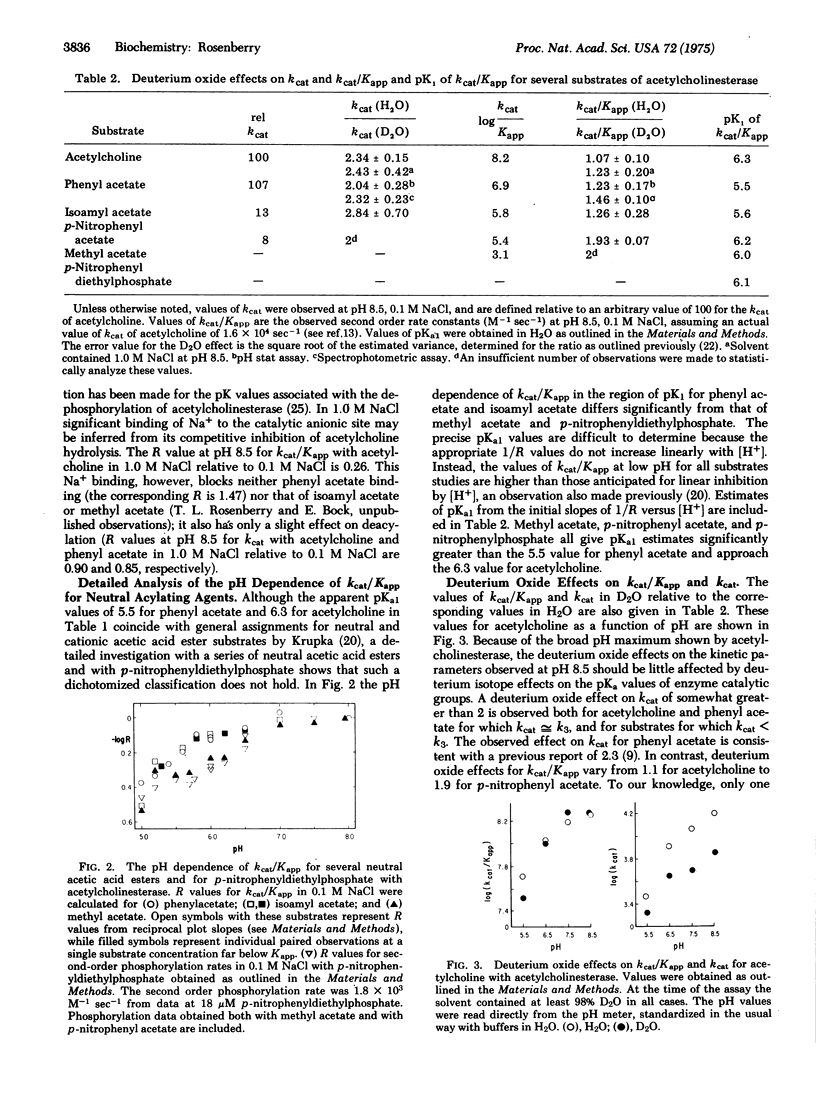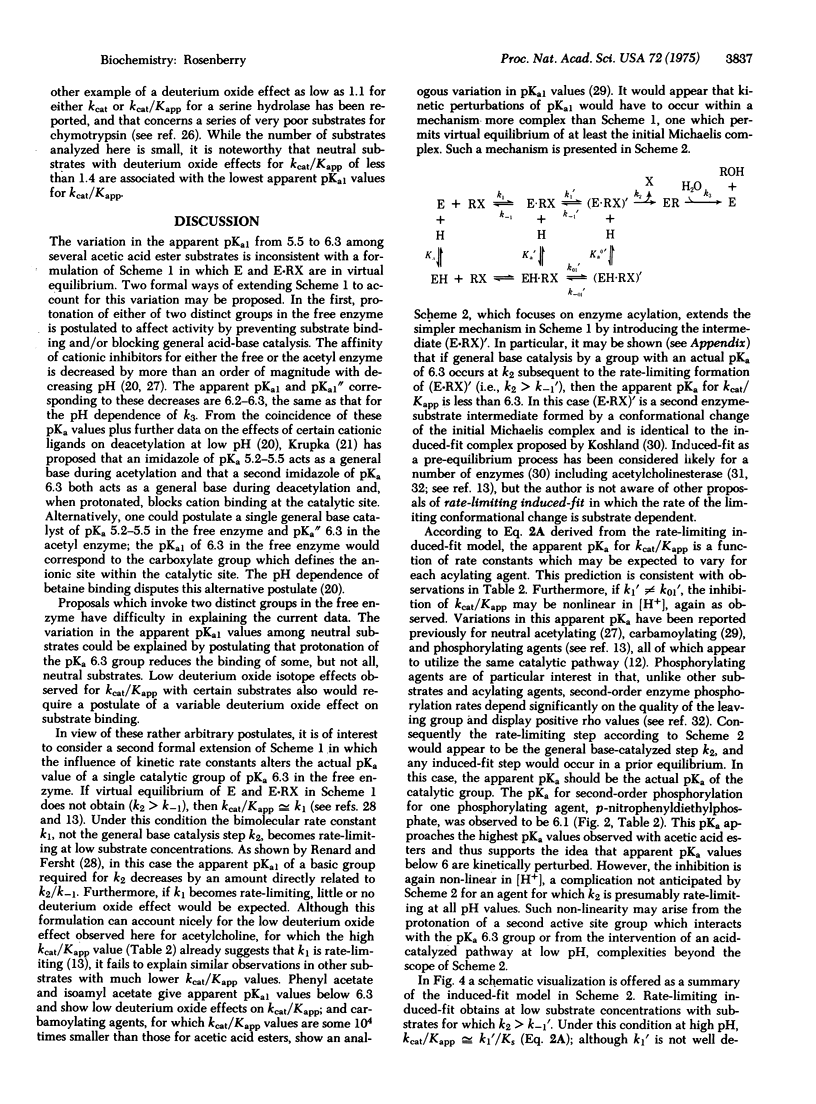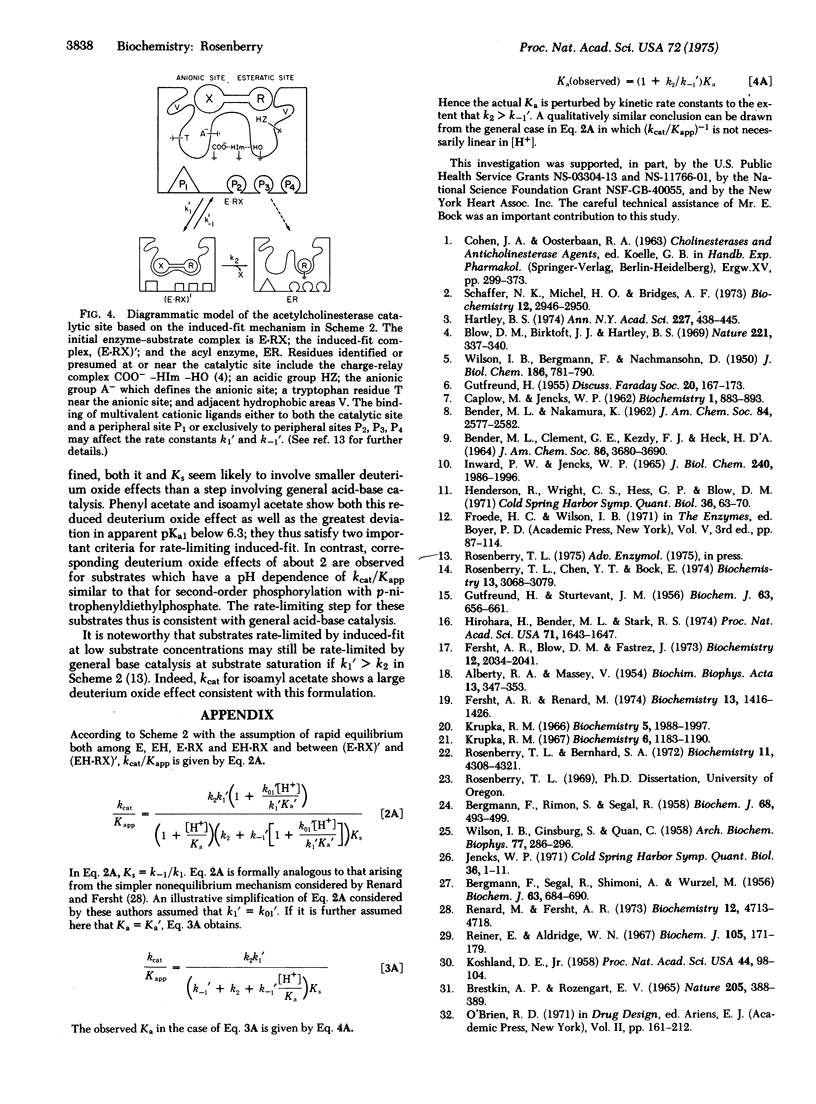Abstract
Inferences about the catalytic mechanism of acetylcholinesterase (acetylcholine hydrolase, EC 3.1.1.7) are frequently made on the basis of a presumed analogy with chymotrypsin, EC 3.4.21.1. Although both enzymes are serine hydrolases, several differences in the steady-state kinetic properties of the two have been observed. In this report particular attention is focused on the second-order reaction constant, kcat/Kapp. While the reported pH dependence and deuterium oxide isotope effect associated with this parameter for chymotrypsin are generally consistent with simple models involving rate-limiting general acid-base catalysis, this study finds a more complicated situation with acetylcholinesterase. The apparent pKa of kcat/Kapp for acetylcholinesterase varies between 5.5 and 6.3 for neutral substrates and involves nonlinear inhibition by [H+]. Deuterium oxide isotope effects for kcat/Kapp range from 1.1 for acetylcholine to 1.9 for p-nitrophenyl acetate. The bimolecular reaction rate appears rate-limiting for acetylcholine at low concentrations, while a rate-limiting induced-fit step is proposed to account for apparent pKa values and low deuterium oxide isotope effects associated with low concentrations of phenyl acetate and isoamyl acetate.
Full text
PDF




Selected References
These references are in PubMed. This may not be the complete list of references from this article.
- ALBERTY R. A., MASSEY V. On the interpretation of the pH variation of the maximum initial velocity of an enzyme-catalyzed reaction. Biochim Biophys Acta. 1954 Mar;13(3):347–353. doi: 10.1016/0006-3002(54)90340-6. [DOI] [PubMed] [Google Scholar]
- BERGMANN F., RIMON S., SEGAL R. Effect of pH on the activity of eel esterase towards different substrates. Biochem J. 1958 Mar;68(3):493–499. doi: 10.1042/bj0680493. [DOI] [PMC free article] [PubMed] [Google Scholar]
- BERGMANN F., SEGAL R., SHIMONI A., WURZEL M. The pH-dependence of enzymic ester hydrolysis. Biochem J. 1956 Aug;63(4):684–690. doi: 10.1042/bj0630684. [DOI] [PMC free article] [PubMed] [Google Scholar]
- BRESTKIN A. P., ROZENGART E. V. CHOLINESTERASE CATALYSIS. Nature. 1965 Jan 23;205:388–389. doi: 10.1038/205388a0. [DOI] [PubMed] [Google Scholar]
- Blow D. M., Birktoft J. J., Hartley B. S. Role of a buried acid group in the mechanism of action of chymotrypsin. Nature. 1969 Jan 25;221(5178):337–340. doi: 10.1038/221337a0. [DOI] [PubMed] [Google Scholar]
- CAPLOW M., JENCKS W. P. The effect of substituents on the deacylation of benzoyl-chymotrypsins. Biochemistry. 1962 Sep;1:883–893. doi: 10.1021/bi00911a022. [DOI] [PubMed] [Google Scholar]
- Fersht A. R., Blow D. M., Fastrez J. Leaving group specificity in the chymotrypsin-catalyzed hydrolysis of peptides. A stereochemical interpretation. Biochemistry. 1973 May 22;12(11):2035–2041. doi: 10.1021/bi00735a002. [DOI] [PubMed] [Google Scholar]
- Fersht A. R., Renard M. pH dependence of chymotrypsin catalysis. Appendix: substrate binding to dimeric alpha-chymotrypsin studied by x-ray diffraction and the equilibrium method. Biochemistry. 1974 Mar 26;13(7):1416–1426. doi: 10.1021/bi00704a016. [DOI] [PubMed] [Google Scholar]
- GUTFREUND H., STURTEVANT J. M. The mechanism of the reaction of chymotrypsin with p-nitrophenyl acetate. Biochem J. 1956 Aug;63(4):656–661. doi: 10.1042/bj0630656. [DOI] [PMC free article] [PubMed] [Google Scholar]
- Hartley B. S. The active centers of serine proteinases. Ann N Y Acad Sci. 1974 Feb 18;227:438–445. doi: 10.1111/j.1749-6632.1974.tb14406.x. [DOI] [PubMed] [Google Scholar]
- Henderson R., Wright C. S., Hess G. P., Blow D. M. -Chymotrypsin: what can we learn about catalysis from x-ray diffraction? Cold Spring Harb Symp Quant Biol. 1972;36:63–70. doi: 10.1101/sqb.1972.036.01.011. [DOI] [PubMed] [Google Scholar]
- Hiroara H., Bender M. L., Stark R. S. Acylation of alpha-chymotrypsin by oxygen and sulfur esters of specific substrates: kinetic evidence for a tetrahedral intermediate. Proc Natl Acad Sci U S A. 1974 May;71(5):1643–1647. doi: 10.1073/pnas.71.5.1643. [DOI] [PMC free article] [PubMed] [Google Scholar]
- INWARD P. W., JENCKS W. P. THE REACTIVITY OF NUCLEOPHILIC REAGENTS WITH FUROYL-CHYMOTRYPSIN. J Biol Chem. 1965 May;240:1986–1996. [PubMed] [Google Scholar]
- Jencks W. P. Structure-reactivity correlations and general acid-base catalysis in enzymic transacylation reactions. Cold Spring Harb Symp Quant Biol. 1972;36:1–11. doi: 10.1101/sqb.1972.036.01.004. [DOI] [PubMed] [Google Scholar]
- Koshland D. E. Application of a Theory of Enzyme Specificity to Protein Synthesis. Proc Natl Acad Sci U S A. 1958 Feb;44(2):98–104. doi: 10.1073/pnas.44.2.98. [DOI] [PMC free article] [PubMed] [Google Scholar]
- Krupka R. M. Chemical structure and function of the active center of acetylcholinesterase. Biochemistry. 1966 Jun;5(6):1988–1997. doi: 10.1021/bi00870a029. [DOI] [PubMed] [Google Scholar]
- Krupka R. M. Evidence for an intermediate in the acetylation reaction of acetylcholinesterase. Biochemistry. 1967 Apr;6(4):1183–1190. doi: 10.1021/bi00856a031. [DOI] [PubMed] [Google Scholar]
- Reiner E., Aldridge W. N. Effect of pH on inhibition and spontaneous reactivation of acetylcholinesterase treated with esters of phosphorus acids and of carbamic acids. Biochem J. 1967 Oct;105(1):171–179. doi: 10.1042/bj1050171. [DOI] [PMC free article] [PubMed] [Google Scholar]
- Renard M., Fersht A. R. Anomalous pH dependence of kcat-KM in enzyme reactions. Rate constants for the association of chymotrypsin with substrates. Biochemistry. 1973 Nov 6;12(23):4713–4718. doi: 10.1021/bi00747a026. [DOI] [PubMed] [Google Scholar]
- Rosenberry T. L., Bernhard S. A. Studies of catalysis by acetylcholinesterase. Synergistic effects of inhibitors during the hydrolysis of acetic acid esters. Biochemistry. 1972 Nov 7;11(23):4308–4321. doi: 10.1021/bi00773a018. [DOI] [PubMed] [Google Scholar]
- Rosenberry T. L., Chen Y. T., Bock E. Structure of 11S acetylcholinesterase. Subunit composition. Biochemistry. 1974 Jul 16;13(15):3068–3079. doi: 10.1021/bi00712a012. [DOI] [PubMed] [Google Scholar]
- Schaffer N. K., Michel H. O., Bridges A. F. Amino acid sequence in the region of the reactive serine residue of eel acetylcholinesterase. Biochemistry. 1973 Jul 17;12(15):2946–2950. doi: 10.1021/bi00739a027. [DOI] [PubMed] [Google Scholar]
- WILSON I. B., BERGMANN F., NACHMANSOHN D. Acetylcholinesterase. X. Mechanism of the catalysis of acylation reactions. J Biol Chem. 1950 Oct;186(2):781–790. [PubMed] [Google Scholar]
- WILSON I. B., GINSBURG S., QUAN C. Molecular complementariness as basis for reactivation of alkyl phosphate-inhibited enzyme. Arch Biochem Biophys. 1958 Oct;77(2):286–296. doi: 10.1016/0003-9861(58)90077-8. [DOI] [PubMed] [Google Scholar]


